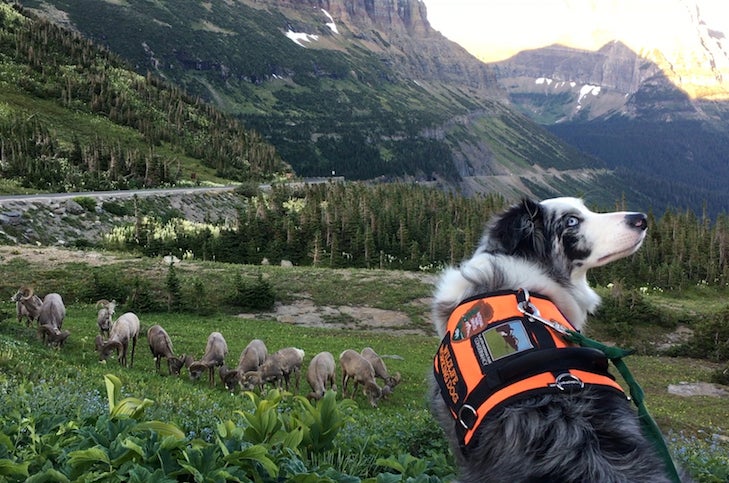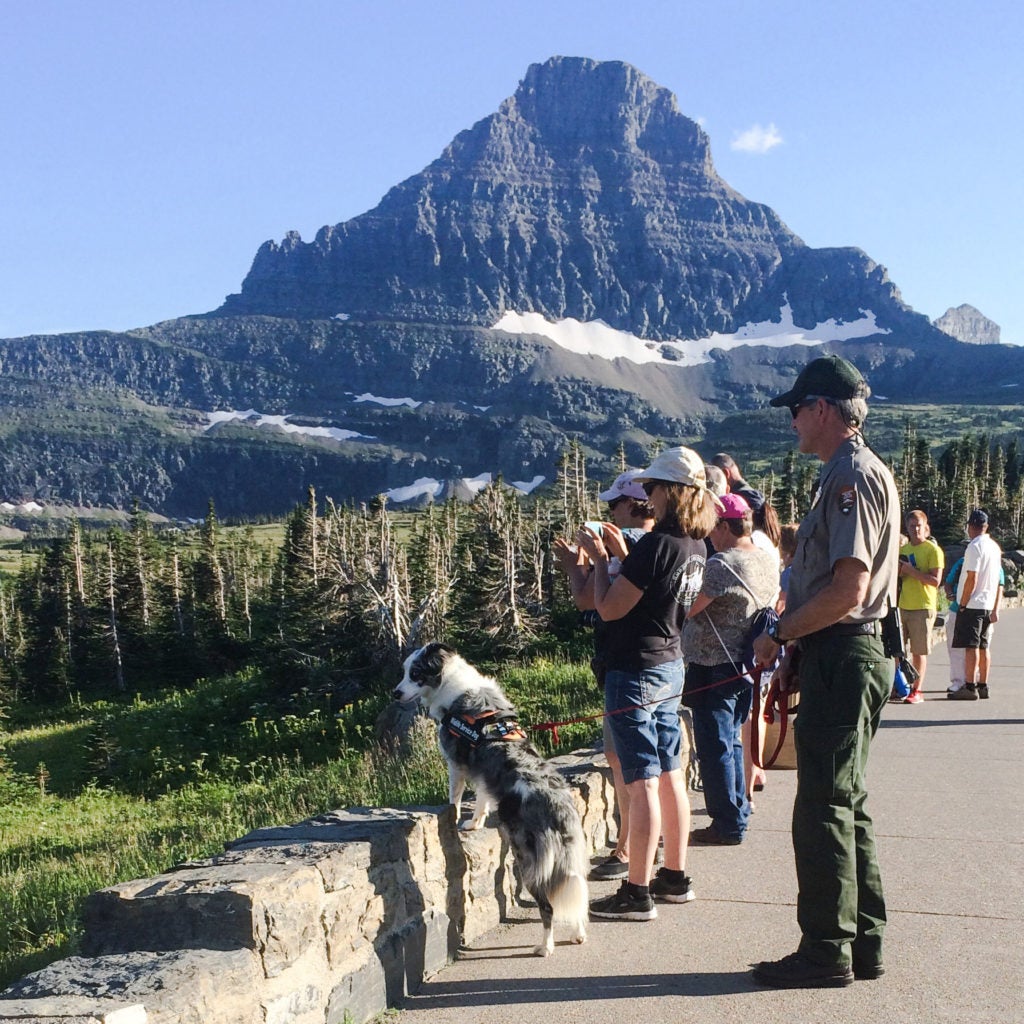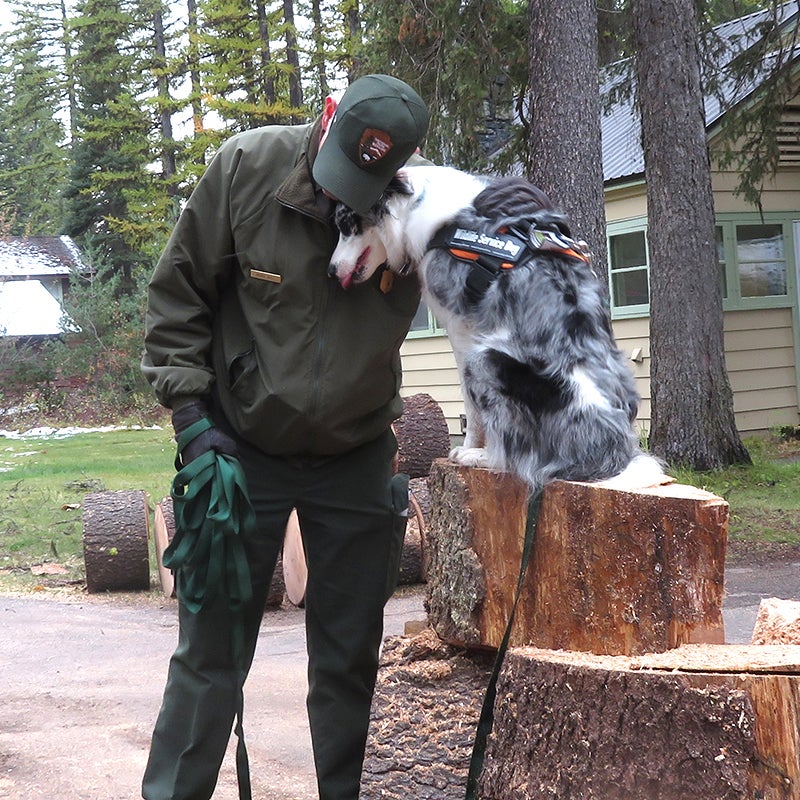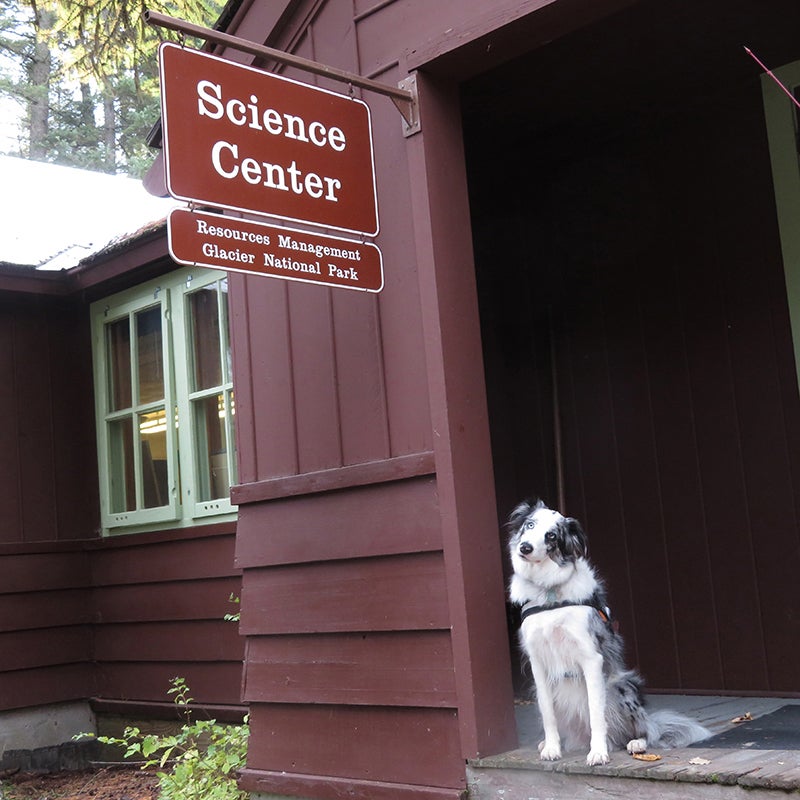
It’s a crisp 60 degrees on a spectacular summer day at Glacier National Park in Montana’s Rocky Mountains. Cascading waterfalls, glacier-carved mountain peaks, and an ark full of wildlife makes this place a paparazzi’s paradise.
The A-list celebs here consist of mountain goats and bighorn sheep who regard the visitor-center parking lot at 6,646-feet–high Logan Pass as a singles club. The most remote and highest point on the 50-mile-long Going-to-the-Sun Road, the pass also serves as a popular trailhead for hikers, bikers, and backpackers.

For Gracie, a 4-year-old Border Collie with her own Instagram account, this is no time for hobnobbing or adventuring. It’s another work day, and this 45-pound herder’s job description includes training the wildlife to keep out of Logan.
Clocking in once or twice a week during the warm months of the year this canine doesn’t take kindly to animals messing around in her hood. Think short doorman in a furry dog suit and an orange service vest with a leash. Her salary? Belly rubs, pats on the head, and a tennis ball chase after hours.
As the first dog in the Montana park’s new Bark Ranger program, funded by the Glacier National Park Conservancy, Gracie is the park’s best tactic in controlling dangerous human-wildlife interactions.
Furry Genius
At 2 years old, Gracie went through 10 weeks of an innovative and intensive training program at the Wind River Bear Institute in Florence, Montana.
“She’s intelligent and learned how to push sheep and goats forward, keeping them a safe distance from the tourist areas,” says Natural Resources Program Manager Mark Biel, Gracie’s owner and handler. “After two weeks of training, I learned how to use the commands with her.”

In the beginning, the idea of driving animals away from people seemed challenging to this Border Collie, as the about-turn works against the breed’s instinct to round up and bring the herd closer.
“Gracie caught on, but I can tell she’s always thinking, ‘For some reason, I thought I was supposed to bring the animals back, not chase them away,’” Biel recalls.
The dog’s appearance also plays a prominent role in pulling off this maneuver. “To us, she looks like a cute, fuzzy dog, but to the sheep and goats, she looks like a scary wolf so they back away,” he says. “Probably her eye color throws them off, too. One eye is brown with a blue spot and the other eye is blue with a brown spot.”
A fan of zany comedic partners Burns and Allen, Biel named his dog after Gracie Allen, whose irises were also two different colors.
Aside from this sweet, sheepish personality in wolf-like clothing, Gracie relies on her breed’s instinctive catlike crouch and intense stare to intimidate and control the animals.

Biel occasionally sees two or three of the mature sheep leaders testing Gracie by grazing closer and closer to her, then stopping and looking at her to see if she means business. “She gives them that hard Border Collie stare that looks right through you and they move back.”
This ultimate herding canine is trained not to touch them and responds to Biel’s voice commands using the standard mushing signals of “gee” and “haw,” which tells Gracie to turn right or left to move the sheep. Biel decided early on not to use a whistle to signal direction as the sound might be misinterpreted.
Bears and Cougars and Moose, Oh My!
As the number of park visitors steadily grew to over 3 million a year with 12,000 a day at Logan Pass, human–wildlife interactions also increased. Park officials realized they needed to up their traditional scare tactics to convince the bovids to stay away from the parking lot.
Shaking cans filled with rocks, waving large garbage bags in the air, and blaring vehicle sirens ceased to frighten them, and they usually returned to the human hangout soon after the commotion stopped. When Gracie and Biel show up at unpredictable times, the animals stay away from the tourist areas for more extended periods of time.
What attracts these cloven-hoofed creatures to people?
In 2016, park rangers conducted a study tracking the goats and found they were becoming less vigilant and moving away from their natural habitat on the cliffs and closer to a predator-free zone at the parking lot.
“They also crave salt and love to chew on sweaty handrails at the overlook or lick at human clothing they find lying around,” Biel says. When they find salty snacks and sweaty bandanas the visitors drop on the ground, it’s like dining at a two-for-one all-you-can-eat buffet.
While no serious incidents occurred at Glacier, other national parks report a few significant people–animal encounters and even an occasional death to visitors and animals. “Goats’ horns are as sharp as knitting needles,” Biel tells FD.
People don’t usually see bears, moose, or elk at home, so when they come to a national park and spot wildlife, they forget how to act around them. Tourists try to feed the animals, take selfies too close to them, or even surround a baby, which never ends well when the mother tries to protect her little one.
Duck, Duck, Goose
The Bark Ranger program at Glacier National Park began when officials wanted to know how other parks were solving their wildlife problem, so they asked around.
“We discovered there’s a rich history of working dogs in national parks to keep wildlife away from high visitor-use areas,” says Lauren Alley, Glacier Parks management assistant. The Wind River Bear Institute trains and uses Karelian Bear Dogs to teach black and grizzly bears to recognize and avoid humans in park boundaries.
Waterton Lakes National Park in the southwest corner of Alberta, Canada, bordering Glacier National Park, relies on Border Collies to move deer out of the nearby town before the deer give birth. Trained Border Collies in Washington, D.C., deter Canada geese from pooping in the National Mall. And to prevent wildlife-aircraft collisions, U.S. airports employ trained herding dogs to chase birds and deer off the runways.
Glacier National Park’s Bark Ranger program has proven so successful that they hope to acquire one or two more ranger-dog teams. “We’re beginning a fund-raising program specifically for that goal,” Biel says.
When Gracie isn’t facing down the bighorn sheep and mountain goats, she’s helping Biel educate tourists about remaining safe around the wildlife. It’s 90 percent of their job, but the ranger believes no one would talk to him if he did this without a dog. “Gracie is a people magnet, and once they see I’m here with a Border Collie wearing a service vest, they immediately come over and start asking me questions about her. Then it’s easy for me to work in some safety reminders.”
In winter, Gracie’s daily occupation involves chasing the mule deer out of the housing area and keeping them at the perimeter of the park. Without traffic or people to contend with, the Border Collie works off leash. “The snow drifts are five to six feet high, and she’ll jump up and look around.
At home with Biel, the Border Collie has energy to spare and figures life out quickly around the house. “She gets bored easily so I need to exercise her brain as well as her body.”

Teaching her a trick only requires two or three lessons before she catches on, and cleanup around the yard goes quickly, too. “If she sees me trimming bushes, she starts pulling branches out. She’s wicked smart, but I wish she wouldn’t shed so much.”
Go Take a Hike
Olympic National Park in Sequim, Wash., encompasses a million acres of glacier-capped mountains, temperate rain forests, and more than 70 miles of wild coastline.
If this sounds like the perfect place to take your dog for a fun run, guess again. With 95 percent designated a wilderness, few areas are dog-friendly.
In summer, 2016 Olympic launched its B.A.R.K. Ranger program to promote responsible pet ownership for hikers and their dogs. Other national parks may adopt the same strategy.
People eager to enjoy Olympic’s diverse park can earn a B.A.R.K. Ranger badge by learning how to hike safely with their dogs and promise to follow B.A.R.K. rules:
- Bag your poop.
- Always wear a leash (six feet maximum).
- Respect wildlife. (Don’t harass or harm them; Keep 25 yards away.)
- Know where you can go.
Originally published in AKC Family Dog.

